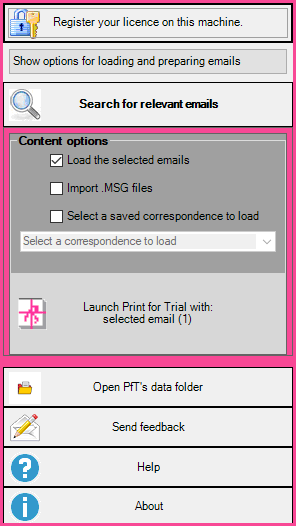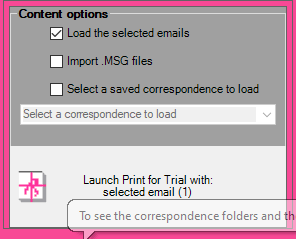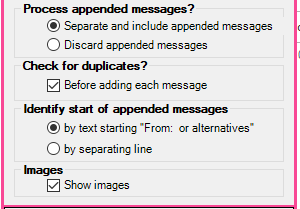Print for Trial, or PfT, adds its button to the Outlook ribbon. (The image below is of Outlook for Microsoft Office 365 MSO (Version 2112 Build 16.0.14729.20156)
When you click the PfT button the menu appears. The screenshots on this page are from PfT version 4.0.0.08
If you do not move the mouse onto the menu it will disappear and it will disappear when you move the mouse off the menu.
Use the contents list below to jump to the relevant section.
Register
Search for emails
Launch PfT
Options for Loading
Open PfT data folder
Sending feedback
Help
About
Register your licence

When you first try PfT the Register button will be the first item on the menu. If you buy a licence the details are stored on Greenhill Software’s licence database. Clicking the Register button will cause PfT to contact the database and store the details of the licence relating to your email address in your computer’s Windows Registry. All restrictions on your use of PfT will then be removed and the Register button will no longer appear on the menu.
Search for emails
If you only want to process a single email, or if you have already selected the multiple emails you want to process then clicking the Launch button will get you going. However, if you need help finding the relevant emails then Outlook’s Search feature will help you. You can type your query straight into Outlook’s search box or you can click the PfT Menu’s Search for relevant emails button. This opens PfT‘s Search Query Builder, a form that lets you enter your search terms, i.e. defining what you are looking for. This may be a single email address or an email domain (so you get the emails of multiple people from the same organisation. If your search is a little more complex, say you want to include emails from two or three different people then the form will help you construct the query in the correct way. For more detail see http://printfortrial.com/search-assistant/.
Launch PfT with selected content
The largest button is the Launch Print for Trial button. It will start the process of PfT loading all the content you have indicated by the tick boxes below.
The darker grey Content options area above the button is a new feature for PfT Version 4. In previous versions you could only process emails within Outlook. Now new options extend the range and power of what PfT can do. Before you click the Launch button at least one of the three tick boxes in the darker area below must be ticked.
Load selected emails: This option is ticked by default so PfT will behave in the way previous users expect. You can un-tick it if appropriate. PfT will load and process whatever emails you have currently selected in Outlook.
Import .MSG files: If you have got messages elsewhere on your system stored as .MSG files you can select and import them. A dialog box allows you to navigate to them and select them. PfT then loads them and processes them in the same way as it does standard emails.
Select a saved correspondence: The third option allows you to load a correspondence dataset that was saved from PfT previously. You do not have find and select the emails all over again. PfT simply loads a named correspondence file with all its messages as they appeared in the Messages Tabs and Messages Grid pages. This means you can come back to continue work on the same correspondence changing selections, choosing different output options, or adding new emails.
NB If you want to load a previously saved correspondence in order to add new emails that are within Outlook then you need to select those emails before click the menu button and launching PfT.
Options for loading and processing emails
At the top of the menu is a button to show the options for loading and processing the selected emails. Most of PfT‘s options control the way its output is created but there are a few which relate to the way PfT loads and processes the selected emails. You would very rarely want to change them but if you did, you would do so before loading the emails. That is why the button is on the menu so you can change the options before loading the emails.
If you click the button to show the options then the menu expands to reveal the possible option settings.
If you change any of these settings then the options panel will remain visible when you view the menu. If you change them back to the defaults then the panel will be hidden the next time you show the menu. PfT will remember any changes you make here but only for the rest of the session. The next time you start Outlook they will revert to their defaults. This is because we think it will be a rare event that you want to change them and would normally revert to the default settings for the next job.
Process appended messages?
Taking the messages added at the end of an email (appended) and putting them in date order is one of the key features of PfT. However, there may be times when you just want just the main message of each email without any of the appended messages.
Check for Duplicates?
When PfT is processing more than one email, identifying all the messages within the email, then before adding a message to its internal data PfT will check whether that message is already in the data (i.e. one sent on the same date and time by the same sender). If it is, then PfT considers that adding the new message would create a duplicate, so it does not. It is possible that PfT could make a mistake in this. When comparing the time sent PfT allows a margin of half a minute. It is unlikely, but theoretically possible, that there were two messages from the same sender within half a minute that were different messages, not duplicates. With this in mind it is possible to turn off this checking.
Remember that one of the purposes of the Messages (grid) tab on the main PfT screen is to allow you to check the messages and de-select any you do not want included. This could include duplicates that PfT has let through.
Identify the start of appended messages
Identifying the start of appended messages within an email is not a simple task. PfT looks for text lines starting with From: or On [date and time] [sender’s name] wrote: However, there are many variations on this simple formula, including foreign languages. Each email provider and each email program may introduce its own twist on a few basic patterns. Also PfT has to go further back in the HTML code of the email to find the start of the relevant section of formatting.
If you encounter a message which PfT fails to identify it may be worth trying the alternative method where PfT simply looks for separating lines. This is usually less reliable but may work in some situations.
Show images
Emails can include images such as logos and other illustrations. This option enables you to choose whether or not to show them. If in doubt, use the Preview page to decide whether having the document with or without images suits you better. If your selected emails take a long time to process and they contain many images then de-selecting this may improve the processing time.
Open PfT’s data folder
Clicking this button will cause Windows to open the folder where any saved correspondence datasets are saved. Each dataset has its own named folder. Within it are a file called Messages.pft which is an XML dataset containing all the separated messages. There may also be a number of subfolders. They will relate to any of the individual emails that formed part of the correspondence that had attachments or embedded images. These are saved within the folder.
This feature creates the possibility of sharing work between users. If the correspondence folder (including any subfolders) is copied from one user and placed in the PfT data folder of another user then the second user could carry on working on the correspondence. (In PfT 4.0.0.0 there is a small limitation on this feature – any embedded images may not appear correctly.)
Sending feedback

Clicking the Send Feedback button will prepare an email addressed to support at Greenhill Software, the makers of PfT, for you to send your comments, questions and suggestions. PfT‘s log file and usage record will be set as attachments to the email. You can open them if you want to see what information is in it.
Getting Help

The Help button will take you to the relevant page on the PfT web site, though you can then use the site’s menu to go to other pages.
Getting details about PfT

Clicking the About button will display a simple message including all the technical details of the software and the current licence details.
Next, see How to use






